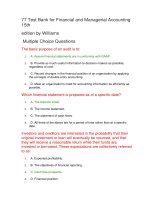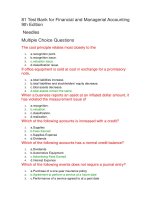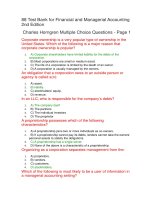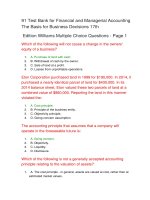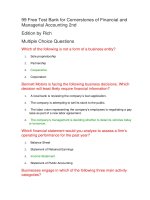Financial and managerial accounting 2nd kimel kieso willey chapter 19
Bạn đang xem bản rút gọn của tài liệu. Xem và tải ngay bản đầy đủ của tài liệu tại đây (2.37 MB, 74 trang )
19-1
19
Cost-Volume-Profit
Learning Objectives
19-2
1
Explain variable, fixed, and mixed costs and the relevant range.
2
Apply the high-low method to determine the components of mixed costs.
3
Prepare a CVP income statement to determine contribution margin.
4
Compute the break-even point using three approaches.
5
Determine the sales required to earn target net income and determine margin of safety.
LEARNING
OBJECTIVE
1
Explain variable, fixed, and mixed costs and the relevant range.
Cost Behavior Analysis is the study of how specific costs respond to changes in the level of business
activity.
19-3
Some costs change; others remain the same.
Helps management plan operations and decide between alternative courses of action.
Applies to all types of businesses and entities.
Starting point is measuring key business activities.
LO 1
Cost Behavior Analysis
Cost Behavior Analysis is the study of how specific costs respond to changes in the level of business
activity.
19-4
Activity levels may be expressed in terms of:
►
Sales dollars (in a retail company)
►
Miles driven (in a trucking company)
►
Room occupancy (in a hotel)
►
Dance classes taught (by a dance studio)
Many companies use more than one measurement base.
LO 1
Cost Behavior Analysis
Cost Behavior Analysis is the study of how specific costs respond to changes in the level of business
activity.
19-5
Changes in the level or volume of activity should be correlated with changes in costs.
Activity level selected is called activity or volume index.
Activity index:
►
Identifies the activity that causes changes in the behavior of costs.
►
Allows costs to be classified as variable, fixed, or mixed.
LO 1
Variable Costs
Costs that vary in total directly and proportionately with changes in the activity level.
►
Example: If the activity level increases 10 percent, total variable costs increase 10 percent.
►
Example: If the activity level decreases by 25 percent, total variable costs decrease by 25
percent.
19-6
Variable costs remain the same per unit at every level of activity.
LO 1
Variable Costs
Illustration: Damon Company manufactures tablet computers that contain a $10 camera. The activity index is the
number of
tablets produced. As Damon manufactures each tablet, the total cost
Illustration 19-1
of the cameras used increases by $10. As part (a) of Illustration 19-1
shows, total cost of the cameras will be $20,000 if Damon produces
2,000 tablets, and $100,000 when it produces 10,000 tablets. We also
can see that a variable cost remains the same per unit as the level of
activity changes.
19-7
LO 1
Variable Costs
Illustration: Damon Company manufactures tablet computers that contain a $10 camera. The activity index is the
number of
tablets produced. As Damon manufactures each tablet, the total cost
Illustration 19-1
of the cameras used increases by $10. As part (b) of Illustration 19-1
shows, the unit cost of $10 for the camera is the same whether
Damon produces 2,000 or 10,000 tablets.
19-8
LO 1
Variable Costs
Illustration 19-1
Behavior of total and unit variable costs
19-9
LO 1
Fixed Costs
Costs that remain the same in total regardless of changes in the activity level within a relevant
range.
Fixed cost per unit cost varies inversely with activity: As volume increases, unit cost
declines, and vice versa.
19-10
Examples:
►
Property taxes
►
Insurance
►
Rent
►
Depreciation on buildings and equipment
LO 1
Fixed Costs
Illustration: Damon Company leases its productive facilities at a cost of $10,000 per month. Total fixed costs of the
facilities will remain constant at every level of activity, as part (a) of
Illustration 19-2
Illustration 19-2 shows.
19-11
LO 1
Fixed Costs
Illustration: Damon Company leases its productive facilities at a cost of $10,000 per month. Total fixed costs of the
facilities will remain constant at every level of activity. But, on a per
Illustration 19-2
unit basis, the cost of rent will decline as activity increases, as
part (b) of Illustration 19-2 shows. At 2,000 units, the unit cost per
tablet computer is $5 ($10,000 ÷ 2,000). When Damon produces
10,000 tablets, the unit cost of the rent is only $1 per tablet ($10,000 ÷
10,000).
19-12
LO 1
Fixed Costs
Illustration 19-2
Behavior of total and unit fixed costs
19-13
LO 1
Fixed Costs
Question
Variable costs are costs that:
19-14
a.
Vary in total directly and proportionately with changes in the activity level.
b.
Remain the same per unit at every activity level.
c.
Neither of the above.
d.
Both (a) and (b) above.
LO 1
People, Planet, and Profit Insight
Gardens in the Sky
Because of population increases, the United Nations’ Food and Agriculture Organization estimates that food production will need to increase by 70% by 2050.
Also, by 2050, roughly 70% of people will live in cities, which means more food needs to be hauled further to get it to the consumer. To address the lack of
farmable land and reduce the cost of transporting produce, some companies, such as New York-based Bright Farms, are building urban greenhouses. This
sounds great, but do the numbers work? Some variable costs would be reduced. For example, the use of pesticides, herbicides, fuel costs for shipping, and
water would all drop. Soil erosion would be a non-issue since plants would be grown hydroponically (in a solution of water and minerals), and land
requirements would be reduced because of vertical structures. But, other costs would be higher. First, there is the cost of the building. Also, any multistory
building would require artificial lighting for plants on lower floors. Until these cost challenges can be overcome, it appears that these urban greenhouses may
not break even. On the other hand, rooftop greenhouses on existing city structures already appear financially viable. For example, a 15,000 square-foot
rooftop greenhouse in Brooklyn already produces roughly 30 tons of vegetables per year for local residents.
Sources: “Vertical Farming: Does It Really Stack Up?” The Economist (December 9, 2010); and Jane Black, “Bright Farms Idea: Greenhouses That Cut Short the Path from
Plant to Grocery Shelf,” The Washington Post (May 7, 2013).
19-15
LO 1
Relevant Range
Throughout the range of possible levels of activity, a straight-line relationship usually does not
exist for either variable costs or fixed costs.
Relationship between variable costs and changes in activity level is often curvilinear.
For fixed costs, the relationship is also nonlinear –
some fixed costs will not change over the entire range of
activities, while other fixed costs may change.
19-16
LO 1
Relevant Range
Illustration 19-3
Nonlinear behavior of variable and fixed
costs
19-17
LO 1
Relevant Range
Range of activity over which a company expects to operate during a year.
Illustration 19-4
Linear behavior within relevant range
19-18
LO 1
Relevant Range
Question
The relevant range is:
19-19
a.
The range of activity in which variable costs will be curvilinear.
b.
The range of activity in which fixed costs will be curvilinear.
c.
The range over which the company expects to operate during a year.
d.
Usually from zero to 100% of operating capacity.
LO 1
Mixed Costs
Costs that have both a variable element and a fixed element.
Change in total but not proportionately with changes in activity level.
Illustration 19-5
Behavior of a mixed cost
19-20
LO 1
1
Types of Costs
Helena Company, reports the following total costs at two levels of production.
Classify each cost as variable, fixed, or mixed.
Variable
Fixed
Mixed
19-21
LO 1
LEARNING
OBJECTIVE
2
Apply the high-low method to determine the components of mixed costs.
High-Low Method
High-Low Method uses the total costs incurred at the high and the low levels of activity to classify
mixed costs into fixed and variable components.
The difference in costs between the high and low levels represents variable costs, since only variablecost element can change as activity levels change.
19-22
LO 2
High-Low Method
STEP 1: Determine variable cost per unit using the following formula:
Illustration 19-6
Formula for variable cost per
unit using high-low method
19-23
LO 2
High-Low Method
Illustration: Metro Transit Company has the following maintenance costs and mileage
data for its fleet of buses over a 6-month period.
Illustration 19-7
Assumed maintenance costs and mileage
data
Change in Costs
($63,000 - $30,000)
$33,000
=
High minus Low
19-24
(50,000 - 20,000)
30,000
$1.10
cost per unit
LO 2
High-Low Method
STEP 2: Determine the fixed cost by subtracting the total variable cost at either the
high or the low activity level from the total cost at that activity level.
Illustration 19-8
High-low method computation of
fixed costs
19-25
LO 2



